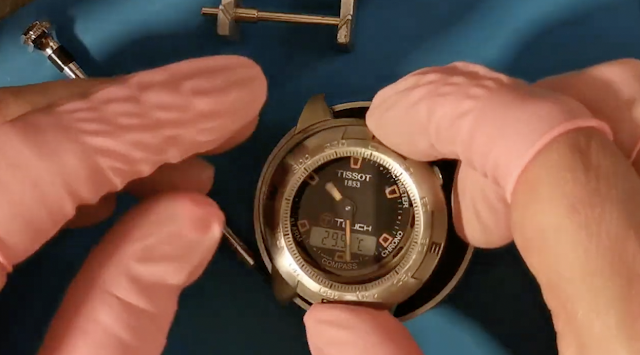T-Touch story and tech info
T-Touch is one of the first smartwatches. The first version of this watch was presented in the 90s.
This watch has several features, like an altimeter, pressure sensor, and compass. Battery last quite long 1-2 years depending on how often these features are used. So it is quite electric effective compared to smartwatches (with these functions).
Diagnosis - Why the watch is not working right
I bought it on eBay - the seller explained that there are some issues with this watch - but I decided to buy and try to fix it. The touch screen allows me to enable only the compass and Chrono features. It doesn't respond when I try to enable the altimeter sensor, pressure sensor, and alarm. There are also many scratches on the watch case. I will try to fix this watch without any parts. We will see how it goes.
I am starting by removing the watch's silicone strap. I open the watch case with a swiss knife. In this watch, it is only a protective layer. It is not water-resistant, and it has holes. These holes are essential for the proper sensor working.
Tissot t-touch case back
There is a pressure and temperature sensor just under the back case. Let me look at this one. It doesn't look good - the sensor isn't sealed:
Because it is not sealed, it is a big chance that it will not work right. Small wires which connect it to the circuit board may be damaged.
Now I am removing the battery. The battery has a water-resistant cover.

I use the watch case opener to remove the watch movement.

An O-ring is attached to the movement, so I need to use an additional tool to remove the movement from the case.
I am removing the elastomeric connector from the movement using rodico cleaning putty.
The elastomeric connector is also called the zebra connector, and it is commonly used in electronic devices. It connects electronic components like, for example, LCDs and circuit boards.
I am examining the connection paths using eyeglass.
There are four connectors under plastic covers, and three more on the right side to check
A silicone-like membrane should cover the pressure sensor. But now, the sensor is exposed and not protected from the environment.
I decided to insert the battery and check if the pressure sensor works correctly. The result is disappointing:
- the altimeter doesn't work,
- the temperature sensor doesn't work,
- and the pressure sensor doesn't work.
Most probably, the connection between the sensor and circuit board is damaged (so this is not only because I can't switch to those features).
85.6C means that there is no right signal from the sensor
The altimeter does not show any data
The repair
I gently clean what is left from the membrane to uncover broken tiny connection wires.
I am fixing the connection between the sensor and circuit board using a cheap microscope. I use liquid silver glue. The sensor size is about 1x2mm, so it is pretty tricky.
Silver conductive Glue adhesive paste at the end of a small watch oil stick
Finally, I put the last drop of silver in the correct place (broken connection).
After a while (silver glue needs some time) I notice that the sensor is operational. There is physically one sensor for temperature and pressure measurements. So if one doesn't work the second one will also not work right (link: how pressure sensor works).
Pressure & temperature sensors show the right data
I am using transparent silicone to recreate the membrane - I don't know if it will work - but we'll find out soon.
Touch screen issue
The elastomeric connector and the circuit paths are clean, so there has to be something wrong with the touch screen. I noticed that I could see paths at some angles. I am putting silver glue at the connection points.





















Comments
Post a Comment